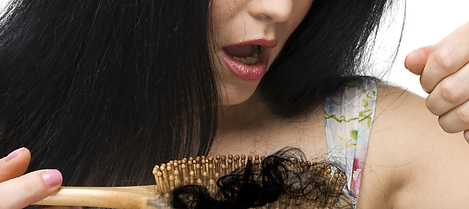Hair

CLINICAL MANIFESTATIONS OF ALLERGY : HAIR
Today, hair is not just the mark of beauty for a woman but the identity factor for men too! However, increasing stress, unbalanced diets, improper care and at times the brunt of diseases has long contributed to uncontrolled loss of hair. It is much of a menace and a mark of disgrace for the sufferer. Though this is a reason of great concern but it is not the end of world. Realm of Homoeopathy has much to offer in terms of counteracting these problems as well as promoting healthy hair, the pride of a healthy body and mind.
Every individual wants to be a cynosure with thick shiny and glossy hair. But reality is that two out of every three persons suffer from alopecia, commonly known as hair loss or baldness. Severe hair loss evokes not only cosmetic concerns but may also evoke feelings of vulnerability, loss of self-esteem, alterations in self-image, and, perhaps, even self-identity.
HAIR-THE CORE CONCEPTS
Hair, which is made up of dead cells filled with keratin grows from small pits in the dermis. The pits, which are called hair follicles, cover most of the body, with certain areas having a heavier concentration than others. For example, the scalp has many hair follicles, while the soles of the feet have none.
HUMAN HAIR GROWTH CYCLE – In every individual, hair growth in hair follicle occurs in a cycle. There are three main phases of hair growth cycle.
ANAGEN is the active growth phase wherein hair fiber is produced. 85- 90% of follicles on normal human scalp are in this active phase at any given time and length of this phase is 2-6 years.
CATAGEN is the second phase. In this phase there are chemical and structural changes in the hair follicle and the hair stops growing. The stage lasts for only 2 -3 weeks.
TELOGEN phase, ultimately the hair follicle enters this phase. Here the follicle is in so-called resting state, which lasts for 30-90 days. Thereafter, it falls out only to be replaced by the next budding hair.
TYPES OF HAIR
Three types of hair grow on the human body.
- The first postnatal hair is vellus hair, soft, usually unpigmented, remains on the hairless regions of the body like forehead.
- At puberty, the vellus hair in some areas is replaced by terminal hair, which are long hair that grow on the head and in many people on the body, arms and legs too. Body hair continues to develop long after puberty, stimulated by male hormones that paradoxically, also cause terminal hair to be replaced by vellus hair when balding begins.
- Lanugo hair – This is the hair that develops on an unborn baby.
HAIR LOSS IN MEN AND WOMEN
air loss usually develops gradually and may be patchy or diffused (all over). Roughly 100 hair are lost from the head every day. The average scalp contains about 100,000 hair. Each individual hair survives for an average of 4½ years, during which time it grows about half an inch a month. Usually in its 5th year, the hair falls out and is replaced within 6 months by a new one. Genetic baldness is caused by the body’s failure to produce new hair and not by excessive hair loss.
By far, the most common form of hair loss is determined by our genes and hormones, also known as androgen-dependent, androgenic, or genetic hair loss. It is the largest single type of recognizable alopecia to affect both men and women.

OTHER PRECIPITATING CAUSES OF HAIR LOSS
- Hormonal changes (for example, thyroid disease, childbirth, or use of the birth control pill)
- A serious illness (like a tumor of the ovary or adrenal glands) or fever
- Medications such as cancer chemotherapy
- Emotional or physical stress
- Burns or radiation therapy
- Alopecia areata — bald patches that develop on the scalp, beard, and possibly, eyebrows. Eyelashes may fall out as well.
- Tinea capitis (ringworm of the scalp)
Nutritional deficiencies can contribute to increased hair shedding by weakening hair shafts that cause breakage of the hair and slow re-growth which can be corrected by a proper diet. Principal nutrients that are involved include vitamin A, certain B vitamins, the vitamin biotin, vitamin C, copper, iron, zinc, protein, and water.
